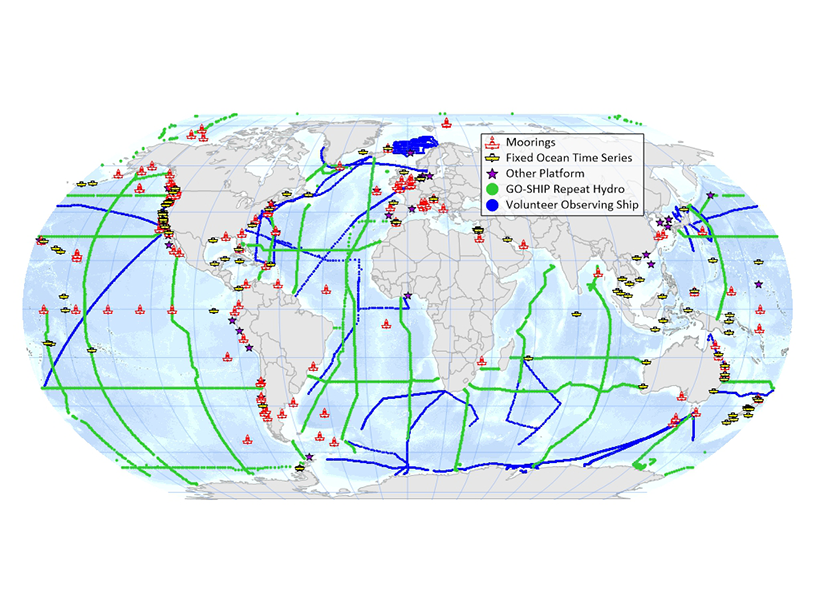Earth’s oceans are absorbing more and more carbon dioxide from the atmosphere, causing ocean acidification (OA) that has harmful consequences for many marine organisms. Among other impacts, this acidification can throw food webs out of balance and negatively affect fisheries upon which humans rely.
The Global Ocean Acidification Observing Network (GOA-ON) is an international collaboration to observe ocean acidification (OA) worldwide, identify drivers of OA and its impacts on marine ecosystems, and provide biogeochemical data to optimize OA modeling and projections.
The Global Ocean Acidification Observing Network (GOA-ON) is an international collaboration to observe OA worldwide, identify drivers of OA and its impacts on marine ecosystems, and provide biogeochemical data to optimize OA modeling and projections. Since its inception in 2012, GOA-ON has built a community of scientists through international workshops and regional training sessions intended to define priorities and approaches that advance these efforts. The 2019 international workshop, the fourth of its kind, was hosted in Hangzhou, China, by the State Key Laboratory of Satellite Ocean Environment Dynamics (SOED), part of the Second Institute of Oceanography within the Ministry of Natural Resources, and was attended by 270 participants from 60 countries.
The workshop had four themes: (1) ocean and coastal acidification in environments with multiple stressors (e.g., ocean warming, hypoxia, harmful algal blooms), (2) observing ocean and coastal acidification and its impacts on organisms and ecosystems, (3) regional and global modeling of physical-biogeochemical coupling processes related to OA and associated ecosystem responses, and (4) shaping GOA-ON to better meet information needs of decision-makers at both international and local levels. Two special events preceded the workshop: a workshop focused on bridging gaps between OA research and the aquaculture industry, which featured key industry representatives who emphasized the importance of OA research for aquaculture efforts, and a course that offered hands-on training with the Ocean Carbon from Space (SatCO2) software, an online platform for analysis of marine satellite and in situ data developed by SOED.
The successes of GOA-ON capacity-building efforts, with multiple training workshops to date involving researchers from 51 developing countries, were highlighted, as was the value of regional collaborative research hubs and the significant role of GOA-ON in increasing OA data availability.
Science sessions highlighted observed biological responses to OA from field and laboratory investigations; the large differences in the time of emergence of acidification signals between the open ocean (roughly 10–15 years) and coastal waters (roughly 20–40 years); and the importance of measuring data of two qualities, “climate” data of sufficient precision and accuracy to observe long-term trends in seawater conditions and “weather” data that are less stringent but adequate to meet the needs of industry and understand ecosystem responses on shorter timescales. The successes of GOA-ON capacity-building efforts, with multiple training workshops to date involving researchers from 51 developing countries, were also highlighted, as was the value of regional collaborative research hubs and the significant role of GOA-ON in increasing OA data availability through its data portal and through the United Nations Sustainable Development Goal 14.3.1 reporting process. Dialogues about OA and hypoxia models from around the world helped workshop participants establish priority needs for ongoing modeling activities, such as maintaining long-term, repeated observations and measuring OA variables along with hydrodynamic and biological variables. Discussions of policy issues identified core needs for policy makers, including the need to focus on a broad range of issues related to ocean health (not only OA) and to involve more perspectives in decision-making, including industry, through the coproduction of projects such as risk assessments.
Overall, the workshop reinforced key tenets of GOA-ON and priorities for the future: (1) Conducting ocean and coastal acidification research involving chemical and biological observation, experimentation, and modeling considering multiple-stressor environments advances understanding of OA. (2) Integrating observational and modeling research speeds progress in both. (3) Assessing how OA is influenced by both natural and anthropogenic processes enables development of effective responses. (4) Collaborating and sharing data and lessons learned with other ocean programs leverage information and maximize understanding. (5) Expanding capacity-building efforts in underrepresented regions and incorporating more training on data management and analysis grow the global OA knowledge base, and (6) communicating and coproducing research across different fields and sectors of society, including social scientists and industry, to assess social and economic vulnerabilities facilitate progress on mitigation and adaptation.
The GOA-ON implementation strategy was released at the workshop to provide guidance on implementing the network’s goals. Parties interested in contributing to the advancement of OA research can find details on joining the effort on the GOA-ON website.
—Jan A. Newton ([email protected]), University of Washington, Seattle; Fei Chai, Satellite Ocean Environment Dynamics, Second Institute of Oceanography, Hangzhou, China; also at University of Maine, Orono; and Minhan Dai, Xiamen University, China
Citation:
Newton, J. A.,Chai, F., and Dai, M. (2019), Progress and planning in understanding ocean acidification, Eos, 100, https://doi.org/10.1029/2019EO128617. Published on 18 July 2019.
Text © 2019. The authors. CC BY 3.0
Except where otherwise noted, images are subject to copyright. Any reuse without express permission from the copyright owner is prohibited.

